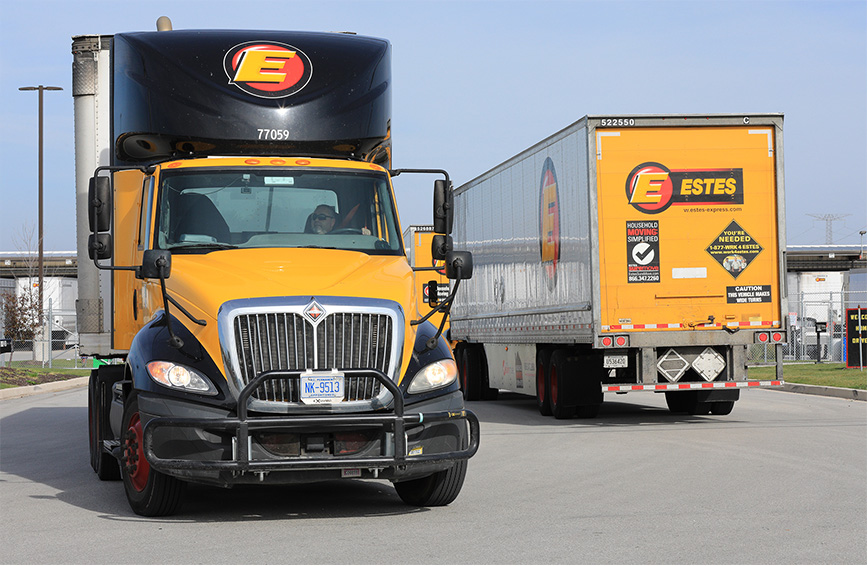Since the beginning of the freight recession, carriers have faced a critical challenge: retaining skilled drivers during economic uncertainty. This period, which has been characterized by a slowdown of freight activities worldwide, has perplexed some carriers whose instinctive response was to simply scale back their operations. However, maintaining a robust driver workforce has shown to not just be a necessity for survival but a strategic investment for the future. The ability to meet post-recession demand hinges on the availability and readiness of drivers.
According to Conversion Interactive Agency's truck driver survey the number of drivers looking for a new job has lowered from 40.2% in fall 2022 to 33.3% in fall of 2023, this remains that one third of your driver workforce is looking for a new job. But, of those not looking for a job, 15.6% cited a need for more experience and 13.9% cited the economy as their reasons for not looking. This near other one-third of capacity will be more likely to move in an upswing. While your capacity may be fitting for the current freight market now, a driver shuffle remains on the horizon.
The task for transportation companies is to implement winning recruitment and retention strategies. To do so requires understanding the evolving needs and concerns of drivers and to implement strategies to address these challenges. In this article, we'll explore driver challenges and provide insights and strategies into how carriers can navigate these turbulent times and emerge with a stronger, more dedicated, and satisfied driver workforce.
Core driver issues and responses
Addressing the core issues drivers face is crucial for retaining them during and after the freight slowdown. With insights from industry experts and survey data, we're granted a clearer roadmap for carriers to understand and effectively respond to these concerns.
Equipment
A primary point of focus for drivers is equipment quality. From survey data found in the Fall 2023 Truck Driver Survey, 33.7% of drivers cited equipment issues as a significant factor in their overall job satisfaction.
Focusing on these concerns, Scott Dismuke said on the Semi-Related Podcast, "It's really about controlling what you can control. You can't keep a truck from breaking down. It's going to happen. What you can control is what does that truck look like when you assign it right out of orientation, and how long that driver either stays in the shop or you get that driver into a loaner if one's available."
Well-maintained trucks and other equipment not only ensure safety and efficiency - they also convey a message of care and respect towards the drivers. "One of the most important things that you can do is give a driver a clean, detailed, inspected, and working truck," Dismuke continued, "because that's going to be their livelihood, that's how you want them to make money, that's how you want them to make you money. So, the worst thing you could do is give them a piece of junk truck."
Compensation
Driver pay is another major issue, accounting for 28% of driver concerns. The freight slowdown has impacted driver earnings, making it more important than ever for carriers to find a balance between pay and mileage. Dismuke also commented on this topic: "A lot of carriers have been like, 'Well, wait, I've been raising pay.' Carriers have been raising pay over the industry. But what that does point to is the freight recession. Again, drivers aren't making what they expect. So, they're going to look at pay rate; they're also going to look at the lack of miles. So, that's usually kind of the balance that I look at from a compensation perspective."
As economic challenges impact the logistics sector, drivers' earnings have become more variable, intensifying their concerns about stable and fair compensation. Carriers must offer competitive and consistent pay structures to retain their workforce.
Operations
Operations accounted for 17.5% of driver concerns. Drivers often complain about being given short-distance assignments while not understanding the larger plan at work. Drivers want to feel as though they're involved in operational decisions at all levels - maintaining clear, consistent communication goes a long way toward ensuring they feel included.
"Most of the communication now that goes to drivers is really through an onboard communication device," said Dismuke. "If you go back to some of our previous surveys, most drivers prefer that phone communication. You're dealing with the segment of the population who works isolated on a day-in and day-out basis. So that personal touch, that interaction with somebody on the other line, is really important."
Personal issues
Issues like driver health and finances are also major reported concerns for drivers, accounting for 7.8% of issues raised. Talking about driver health issues on the Semi-Related Podcast, Mark Manera said: "I continued to see repeatedly this explosive surge of chronic diseases across the whole trucking industry - diabetes, obesity, and heart disease. What I recognized was it's a much bigger issue than most people recognize."
Drivers must know their health and safety are a priority in the companies they work for, otherwise they'll neither feel recognized nor appreciated. However, their personal financial stability and the stress that comes with uncertainty also plays a significant role in their overall health. "When you talk to drivers about what's stressing them," said Dean Croke on the Semi-Related Podcast, "it's always some problem at home, and it's almost always got to do with finances… If you don't have a happy home life, it's impossible to be successful over the road or as a truck driver for a longer term.
While many problems stem from issues at home, carriers can build the relationship to help drivers manage these issues. Carriers are more frequently implementing programs to address physical, financial, and spiritual needs of their drivers to achieve better quality of life.
"The smart companies are working very closely with financial planners to help families get financing, get some debt to make a start in life - and that makes the connection between the job and the home," Croke said.
Home time
Home time made up 4.7% of drivers' most concerning issues. Managing your drivers' expectations regarding home time with honesty and respect is absolutely necessary. When you can balance your operational needs with drivers' personal time, it can significantly impact how satisfied they feel with their jobs.
"When you tell a driver you will get the home, get them home. If you can't get them home, tell them why… At least have the decency to give them the honest answer," Dismuke said.
Orientation and training
Drivers' orientation and training process makes up another 3.8% of their main concerns. These are broken down easily into three key areas:
- Connection: Drivers are too often hired through remote hiring processes. "[Drivers are] on the phone with somebody that nine times out of ten they never meet that's going to hire them in a recruiter," Dismuke said. "As a result, it's increasingly more rare that drivers get the chance to build personal relationships with other members of the companies they work for. If companies want their drivers to feel valued, they should work on creating situations where drivers are included, even if face-to-face meetings are uncommon."
- Information overload: Drivers can feel seriously overwhelmed by the sheer amount of information they receive during orientation sessions. "We bring them in for orientation for two or three days," Scott Dismuke said, "we feed them water through a fire hose with information of all the stuff we expect them to remember." Such a rapid-fire blasting of information can leave drivers potentially feeling ill-prepared for the demands of their jobs. Companies must develop a more gradual method of delivering key information drivers can utilize to feel confident and competent in their roles.
- Equipment condition: When a driver is assigned a truck, the state of the vehicle can significantly influence their perception of the company - the respect it should garner along with their personal job satisfaction. "With them, it was all about respect," said Dismuke. "It tells us how a company feels about me as a driver… Give a driver a clean, detailed, inspected, and working truck." This way, their initially feelings toward the company will be more positive, and they'll be able to feel pride in what is essentially their workspace and how it reflects on them as they move along our nation's highways.
Company preference
Some drivers prefer working for carriers of a specific size and atmosphere, as indicated by 2.5% of drivers in the survey. 12.9% of drivers preferred working for smaller carriers, while 5% wanted to work for larger carriers. This reflects a trend towards seeking more personalized work environments, with stronger communities and closer relationships with their employers.
According to the Q3 2023 Driver Recruiting & Retention Data Download report, drivers are also strongly influenced by online reviews and company social media presence when making job decisions.
Team issues
Finally at 1.7%, it's worth noting that some drivers consider team problems a core concern. Team driving, where two drivers operate the same vehicle and take turns driving, can often be a more lucrative and functional way of getting to their destinations on each trip. However, some drivers are unsatisfied with the situation - either due to their relationships with their team members or their lack of complete control along every mile of the journey. For drivers to feel positively about their overall work environment and satisfied in their roles, they should feel a sense of belonging to a team that works together cohesively and successfully. Otherwise, they may start to look elsewhere.
Navigating the freight slowdown with strategic driver retention strategies
It's clear that reaching the other side of the current, waning freight slowdown will require a multifaceted approach to driver retention. The insights we've gained from expert opinions and industry surveys can provide carriers with a series of solutions for retaining their driver workforce during these times - and any other challenges down the road. It isn't just about weathering the current storm - it's about positioning your company for future success when our market inevitably rebounds.
Key takeaways for carriers
- Understand driver concerns: It's important for carriers to recognize the shift in driver priorities toward job security and stability. If your business can address these concerns head-on, you'll foster a sense of trust and loyalty among your valued driver workforce.
- Invest in equipment and compensation: Your drivers should feel as though they have access to well-maintained equipment. They should also know they're receiving fair compensation - especially when they compare against your competitors.
- Leverage technology in recruitment: Utilizing social media and other digital tools can streamline your recruiting process, but it also lets your existing workforce know you care about staying up-to-date with the latest trends.
- Ensure operational excellence: If you involve your drivers in planning, ensure equipment issues are resolved properly, and help your drivers maintain a healthy work-life balance, you'll create a healthier, more optimistic atmosphere in the workplace you and your drivers share.
At the end of the day, drivers need to know they are valued. That requires a comprehensive and empathetic approach to driver retention - one that addresses their core concerns whenever possible. In so doing, your company can emerge from the 2023 freight recession stronger and more capable of generating future growth.


-2.jpg)

